Palatine Hill
Guide to visit Palatine Hill
The Palatine Hill is located near the Colosseum and the Roman Forum. It’s also walking distance from the Circus Maximus and Piazza Venezia so you have zero excuses to not going and see it by youself!
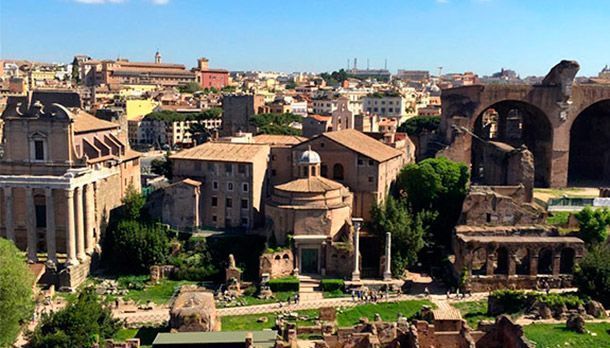
The must-see sights through the Palatine Hill are:
- The Flavian Palace, an enormous palace built during the reign of the emperor Domitian in 92 AD.
- The Stadium of Domitian, although it’s unsure the function of the building it may have been the emperor’s private garden.
- The House of Augusts and House of Livia, these houses can be visited but tickets need to be purchased in advanced, you can see the beautiful colorful frescoes that are still well-preserved.
The Palatine Museum is a small museum that contains a wide display of Roman statues and findings from the hippodrome, here you can find information that will provide you with historical context and you can also find some ancient artefacts on display dated back to the beginning of Roman history.
Consider the following tips when sightseeing: visit the Palatine Hill during the hottest part of the day. Bring a packed lunch and make most of the shade. There a drinkable fountains all along the way, so don’t forget your bottle to refill.
The must-see sights through the Palatine Hill are:
- The Flavian Palace, an enormous palace built during the reign of the emperor Domitian in 92 AD.
- The Stadium of Domitian, although it’s unsure the function of the building it may have been the emperor’s private garden.
- The House of Augusts and House of Livia, these houses can be visited but tickets need to be purchased in advanced, you can see the beautiful colorful frescoes that are still well-preserved.
The Palatine Museum is a small museum that contains a wide display of Roman statues and findings from the hippodrome, here you can find information that will provide you with historical context and you can also find some ancient artefacts on display dated back to the beginning of Roman history.
Consider the following tips when sightseeing: visit the Palatine Hill during the hottest part of the day. Bring a packed lunch and make most of the shade. There a drinkable fountains all along the way, so don’t forget your bottle to refill.

History of Palatine Hill

The Palatine Hill is one of Rome’s most ancient parts of the city and has been known as “the first nucleus of the Roman Empire”. Located on the centermost of one of the seven hills, it’s 40 metres tall and is composed of a line of houses -also known as palaces- that were mainly occupied by wealthy men and nobles from ancient Rome. Completed with a privileged view of the Roman Forum and the Colosseum, emperors and kings where the main occupants of the most prestigious buildings in Rome and where they hosted many feasts and gatherings that would shape the future on Roman Empire and it’s later conquest.
Rome first began in the Palatine Hill. Excavations show that people have lived there since the 10 century BC, were a collection of huts have been uncovered and believed to have been used for funerary purposes between the 9th and 7th century BC, close to the time period.



History of Palatine Hill
The Palatine Hill is one of Rome’s most ancient parts of the city and has been known as “the first nucleus of the Roman Empire”. Located on the centermost of one of the seven hills, it’s 40 metres tall and is composed of a line of houses -also known as palaces- that were mainly occupied by wealthy men and nobles from ancient Rome. Completed with a privileged view of the Roman Forum and the Colosseum, emperors and kings where the main occupants of the most prestigious buildings in Rome and where they hosted many feasts and gatherings that would shape the future on Roman Empire and it’s later conquest.
Rome first began in the Palatine Hill. Excavations show that people have lived there since the 10 century BC, were a collection of huts have been uncovered and believed to have been used for funerary purposes between the 9th and 7th century BC, close to the time period.
The Palatine Museum



The Palatine Museum is located where the former Monastery of the Visitation used to be, built in 1868 on the ruins of Domitian’s palace. The layout is divided into two floors. The ground floor has rooms that preservate the original structures of the pre-existing domus, and it narrates the history of the Palatine Hill starting from the origins of Rome up until the advent of the Principate (1st century BCE). On the first floor, you will find many works on display and you shouldn’t miss in Room VI, the findings from the age of Augustus, the emperor that first changed the appearance of the Palatine and in Room VII, you can see the mosaics and fine paintings from the Domus Transitoria.
The Palatine Museum
The Palatine Museum is located where the former Monastery of the Visitation used to be, built in 1868 on the ruins of Domitian’s palace. The layout is divided into two floors. The ground floor has rooms that preservate the original structures of the pre-existing domus, and it narrates the history of the Palatine Hill starting from the origins of Rome up until the advent of the Principate (1st century BCE). On the first floor, you will find many works on display and you shouldn’t miss in Room VI, the findings from the age of Augustus, the emperor that first changed the appearance of the Palatine and in Room VII, you can see the mosaics and fine paintings from the Domus Transitoria.



The Palatine Palace
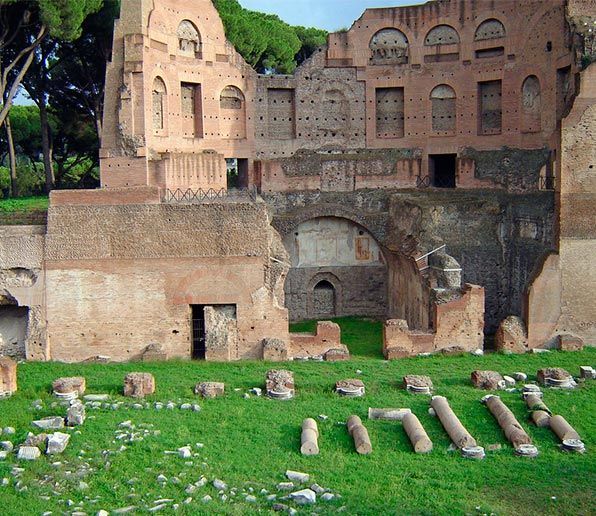


The largest building that you will find on the Palatine Hill is the Palace of Domitian. This wide complex served as the official residence for Roman Emperors over 300 years. The construction of the Palace of Domitian was completed in 92 AD by the Emperor Titus Flavius Domitianus, but later it was expanded by Septimius Severus. The palace consisted of three different parts that allowed Domitian to separate his business and personal life as well. The three parts were the Domus Flavia, Domus Augustana, and the stadium. The sheer size of the ruins give you a look on how grand and elegant the palace used to be.



The Palatine Palace
The largest building that you will find on the Palatine Hill is the Palace of Domitian. This wide complex served as the official residence for Roman Emperors over 300 years. The construction of the Palace of Domitian was completed in 92 AD by the Emperor Titus Flavius Domitianus, but later it was expanded by Septimius Severus. The palace consisted of three different parts that allowed Domitian to separate his business and personal life as well. The three parts were the Domus Flavia, Domus Augustana, and the stadium. The sheer size of the ruins give you a look on how grand and elegant the palace used to be.
The House of Livia
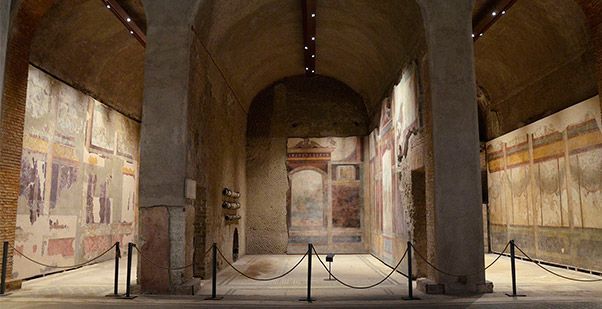


The House of Livia is a rich and private domus from the 1st century BC, discovered in the 19th century, and it has been attributed to Livia because of the name Iulia Augustua that was found engraved in a lead pipe visible in the reception room. The building structure is made of a quadrangular atrium surrounded by four spaces with painted walls and mosaics floors, dated to 30 BC.
The House of Livia
The House of Livia is a rich and private domus from the 1st century BC, discovered in the 19th century, and it has been attributed to Livia because of the name Iulia Augustua that was found engraved in a lead pipe visible in the reception room. The building structure is made of a quadrangular atrium surrounded by four spaces with painted walls and mosaics floors, dated to 30 BC.



The House of Augustus
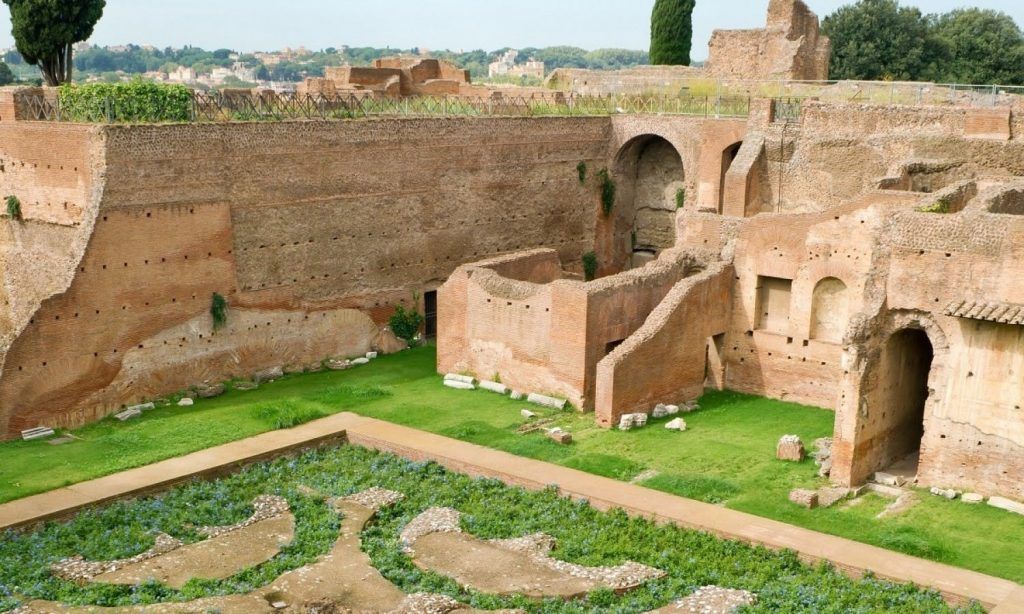


The House of Augustus – Domus Augusti in Latin – is the first major building you will find when entering the Palatine Hill and get your impression on ancient Rome. This house has been identified as the primary residence of Augusts, the first Emperor of Rome. It is a symbol of an important transition in Roman history, when the Palatine Hill was turned from a residential place into the seat of Imperial power.



The House of Augustus
The House of Augustus – Domus Augusti in Latin – is the first major building you will find when entering the Palatine Hill and get your impression on ancient Rome. This house has been identified as the primary residence of Augusts, the first Emperor of Rome. It is a symbol of an important transition in Roman history, when the Palatine Hill was turned from a residential place into the seat of Imperial power.
Farnese Gardens
The Farnese Gardens are laid out in terraces on the side of the the Palatine Hill. These magnificent botanical gardens, one of richest in the world during the time period, once extended across the flat top of the hill. They were created by Cardinal Alessandro Farnese and were the first private botanical gardens in Europe.
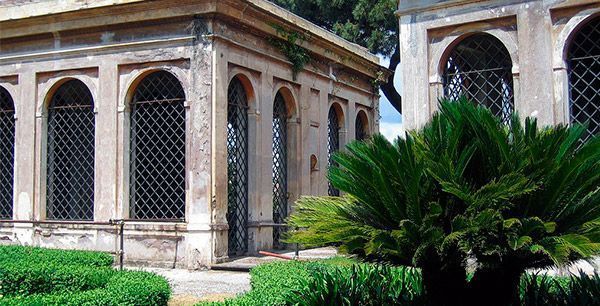

The Circus Maximus Stadium
The Circus Maximus is an ancient Roman chariot-racing stadium and mass entertainment venue located between the Aventine and the Palatine Hill. It was the first and biggest stadium built in ancient Rome. The Circus Maximus was used as a chariot-racing circuit and for religious processions at grand scale as well.
Temple of Apollo



The Temple of Apollo Palatinus was a temple located on the Palatine HIll built in ancient Rome. First dedicated by Augustus to his patron god Apollo. It was the second temple built in Rome dedicated to the god, after the Temple of Apollo Sosianus. The ruins of the building were excavated in the 1960s, in an sloped area going down towards the Circus Maximus.



Temple of Apollo
The Temple of Apollo Palatinus was a temple located on the Palatine HIll built in ancient Rome. First dedicated by Augustus to his patron god Apollo. It was the second temple built in Rome dedicated to the god, after the Temple of Apollo Sosianus. The ruins of the building were excavated in the 1960s, in an sloped area going down towards the Circus Maximus.